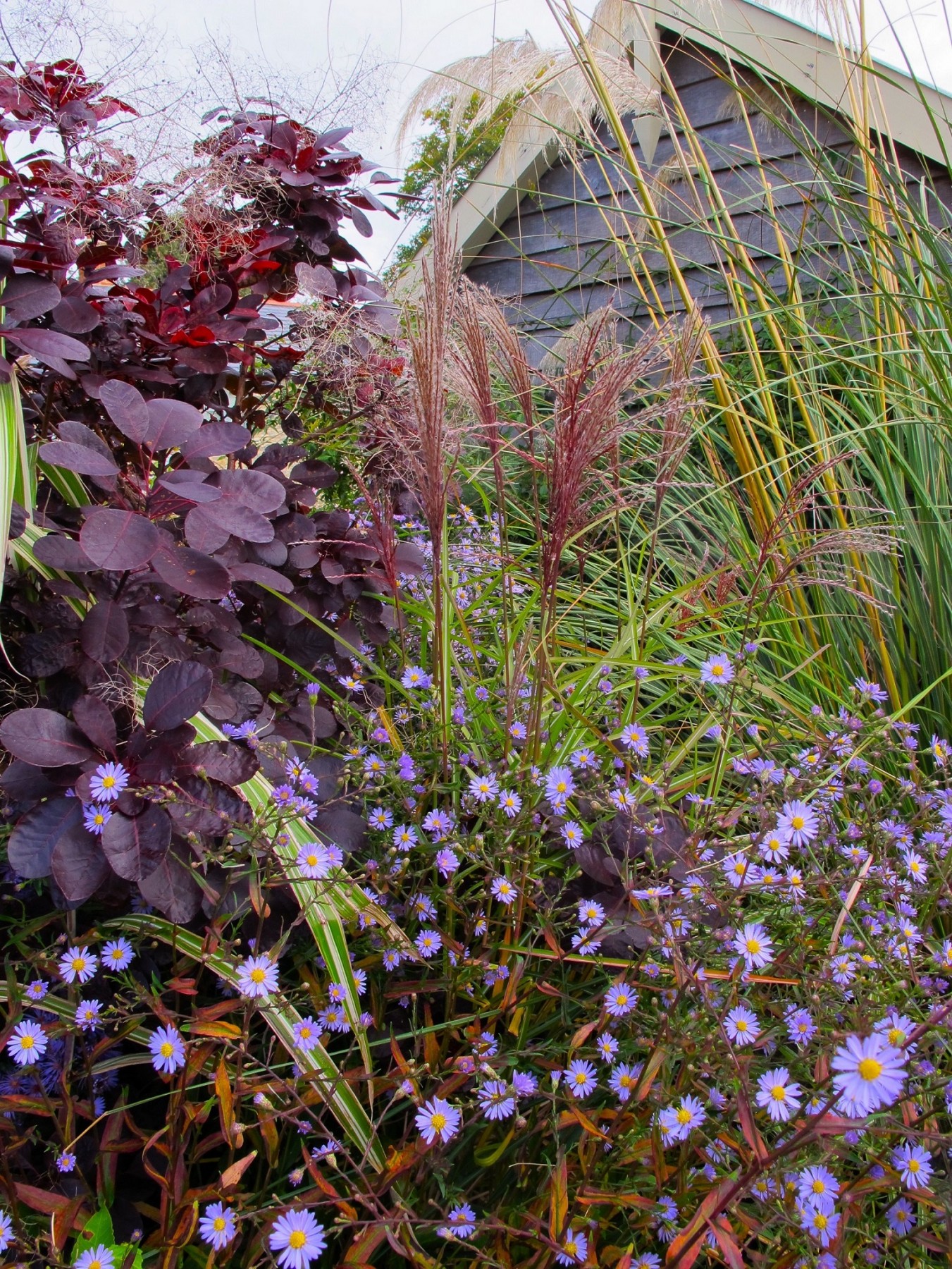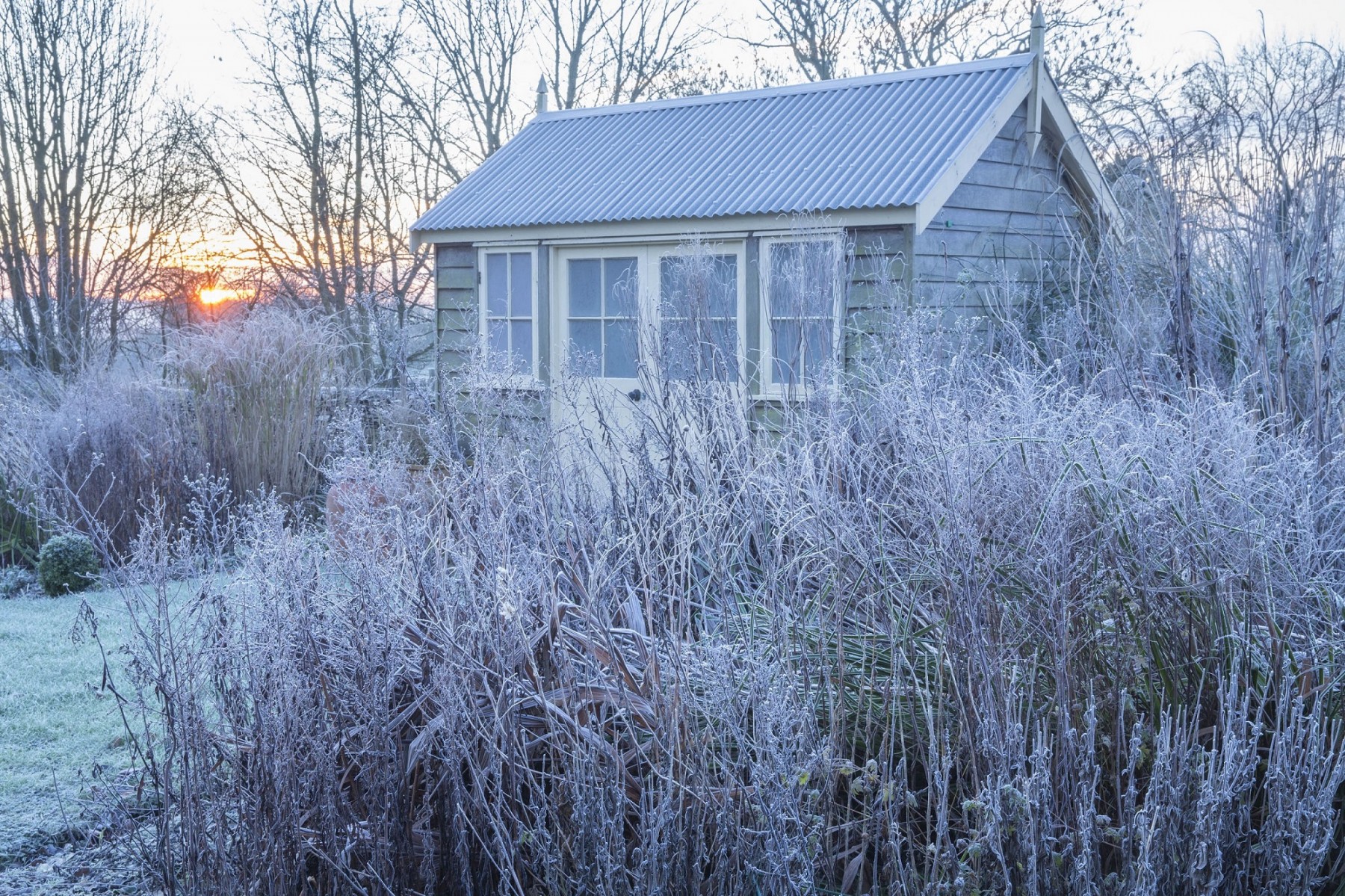
At the back end of the year the plants that draw my eye at Spring Cottage, more than any other, are the grasses because low winter sunlight shows them off really well once most of the garden has faded. Some form beaded, gossamer veils and others are like strong punctation marks. Others swirl and curl, like fine fibre-optic lamps, and some just shimmy and shake.
Although I love them, grasses are not easy things here because we’re cold and bleak. Many are on the edge of their natural range and they might flower willingly in July and August in the banana belt of southern England. However they only creep into flower here in early September. Miscanthus sinensis, probably the best substantial grass to explore because named forms are variable and offer different things, is a good example of a grass that can be reluctant to flower. At RHS Wisley in Surrey and at Great Dixter in East Sussex, Miscanthus sinensis is always glorious by mid-July, but I have to wait another six weeks for my plumes, despite the fact that Great Dixter and Wisley are a mere hundred miles away as the crow flies.
This flowering time lapse has a knock on effect when it comes to choosing varieties. Those in the soft south tend to shun ‘Silberfeder’ because it’s the first to flower and by winter the heads have broken up and disintegrated. I gladly grow and recommend ‘Silberfeder” here, because I know it will flower for me at the end of August or beginning of September. It’s a German variety raised by Hans Simon in the 1950s.
I first saw ‘Silberfeder’ ( and fell in love with it) in Alan Bloom’s Dell Garden at Bressingham in Norfolk, a garden everyone should visit because The Dell is packed with hundreds of plants, all correctly labelled. It was in the 1990s and the silvery plumes of this miscanthus were jostling with a tall, autumn-flowering, rich-blue monkshead Aconitum carmichaelii ‘Arendsii’. This self-supporting, man-high thick-stemmed monkshood has wonderful foliage and so many aconitums don’t. Beth Chatto sells the correct plant. www.bethchatto.co.uk
Grasses weren’t seen in many gardens back then, but Alan Bloom was a pioneer and he made lots of visits to Germany in his quest to find exciting plants. ‘Silberfeder’ was raised by Georg Arends (1863-1952) who had a nursery in Ronsdorf in the Rhur district. He was most famous for breeding astilbes and Alan Bloom was “greatly impressed” by him and the two men became friends. Alan Bloom went on to introduce many of Arend’s plants including Miscanthus sinensis ‘Silberfeder’ and five bergenias. The best two being ‘Abendglut’ and ‘Silberlicht’.

Alan, who was one of my dearest friends, died in 2005 aged 98, but his garden is in safe hands and whilst visiting The Dell a few years ago the present curator and his son-in-law, Jaime Blake, gave me a less hardy Miscanthus from the Himalayas and Burma ( M. nepalensis). This survives in East Anglia, where winters are drier, but I was convinced that it wouldn’t grow for me on the soggy Cotswolds. However it has thrived in a south-facing hotspot and this year it produced eighty deep-gold, frizzy heads in August. These look amazing, now growing next to Melianthus majus, so I hope that it will keep going forever.
Alan also knew Karl Foerster (1874 – 1970) a landscape architect and nurseryman from Germany. He didn’t admire him as much as Arends though and that was from the horse’s mouth as it were. Foerster’s Dahlem nursery was behind the Iron Curtain, so his plants tended to take a long time to emerge. Foerster was the first nurseryman to appreciate the beauty of grasses and he called them “nature’s hair”. There are two grasses named after him. Calamagrostis x acutiflora ‘Karl Foerster’ is a real designer’s plant, because it creates a tight sheath of stems that ascend vertically gradually weathering from green to russet brown. It’s sterile, so doesn’t set seed, and it’s clump-forming. It’s used en masse in America and Germany and designers such as Piet Oudolf always use it.
There’s also another grass, Molinia caerulea subsp. arundinacea ‘Karl Foerster and this turns a wonderful shade of gold in early September from tip to toe. Here it grows near the finely beaded ‘Transparent’. These tall molinias, the ones labelled arundinacea or arundo-like, tend to collapse in early December and have to be cut down. However they do flower from July onwards so they’re still good value.
One of Karl Foerster’s protégés was Ernst Pagels (1913 -2007 ) and he was undoubtedly the most important German plant breeder of perennials including grasses. I once got the chance to visit his nursery, but turned it down, and now bitterly regret not seeing his nursery drive at Leer, which was planted with some of the 50 varieties of Miscanthus he raised. He made this breakthrough having persuaded an old Miscanthus called ‘Gracillimus’ to flower and set seed under glass. He carried on growing the seedlings, selecting for early flowering and form.

When the RHS held a Miscanthus trial at RHS Wisley between 1998 – 2003, there were hundred or so named species and cultivars. A quarter of them had been raised by Pagels and half of those awarded an AGM were raised by him. They included an early maroon-flowerer called ‘Ferner Osten’, literally Far East, and the brown-flowered ‘Ghana’. I use them in my autumn border as fillers between tall herbaceous plants.
The summer borders also contain Ponytail grass, Stipa tenuissima and this was in every show garden at one time. It has fine foliage that develops to bleached straw by summer, but it also shines in winter when the fine filaments take on a bleached look. It’s far less showy than Stipa gigantea which fountains out to produce its own golden rain. If we get a good summer another handsome grass, Stipa barbata, produces ostrich-like long plumes that detach themselves and float round the garden in August. The nib-like ends get wound into the soil by a corkscrew mechanism, operated as the stem twists in damp conditions and then straightens in dry weather. This rather short-lived grass needs warmth and good drainage. Snap it up if you see it though, because it’s rarely for sale ,and my seed heads are in constant demand. It does self-seed and the seeds germinate if plunged into damp, coarse horticultural sand. Admittedly Stipa barbata is not a winter beauty, but just having it perform in summer is enough.
The puzzling this is that lots of great gardeners are wary about planting grasses and I can’t quite work out why. They should visit Spring Cottage on a bright winter’s day! That all I can say.











